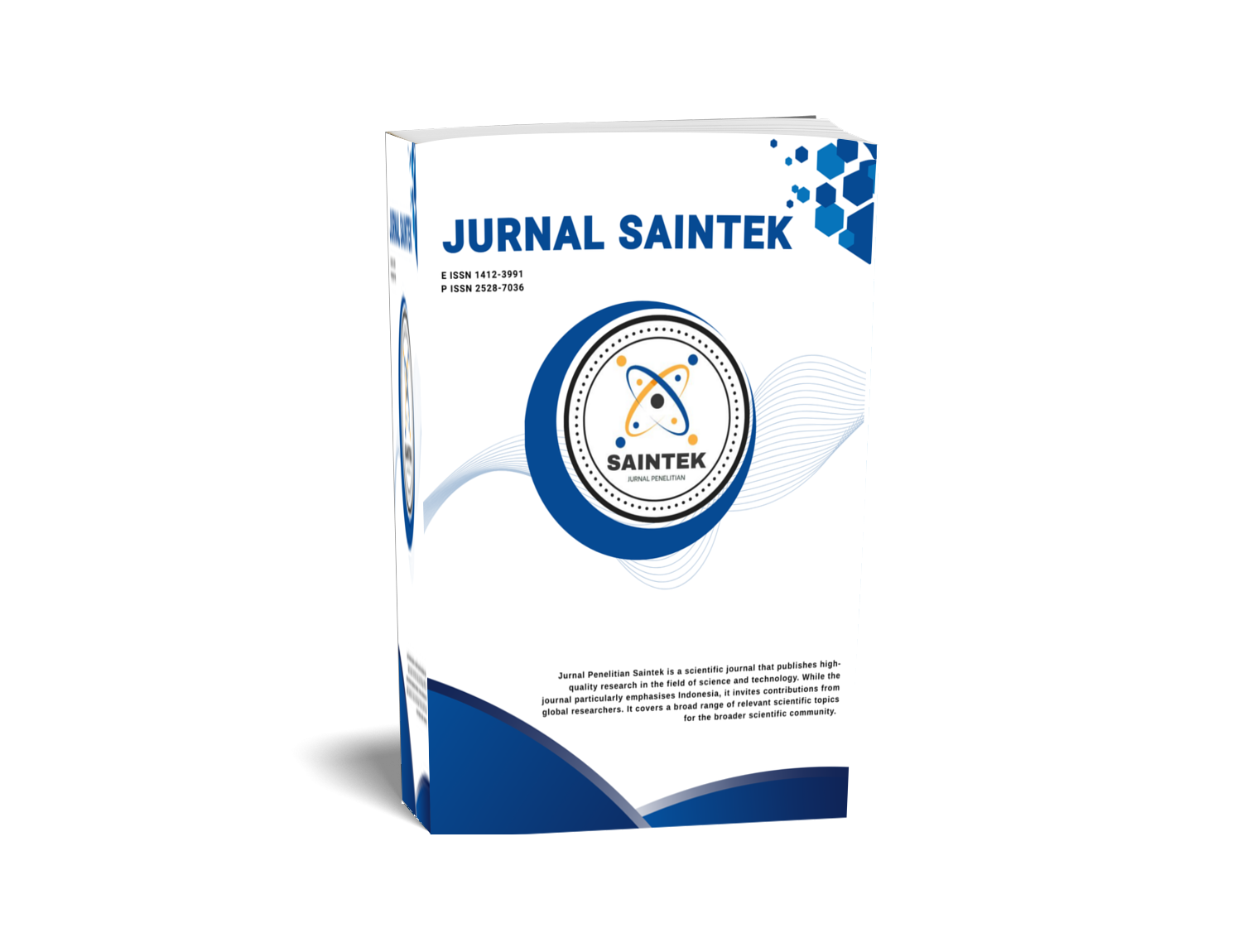THE EFFECTS OF PRESSURE AND TYPE OF FILLING GEL TOWARD THE INTENSITY OUTPUT IN PLASTIC OPTICAL FIBER
DOI:
https://doi.org/10.21831/jps.v23i1.21470Keywords:
polymer optical fiber, gel, pressure sensorAbstract
This study was aimed at determining the effect of applying pressure to changes in optical fiber output intensity, giving various kinds of filling gel on the connection to fiber optic output. The optical fiber used was Polymer Optical Fiber (POF) type SH-4001-1.3. This POF has a core refractive index of 1.49 and a cladding refractive index of 1.41. The gel was inserted between the optical fiber with a length of 1 cm in a small pipe, then given a variation of pressure so that it affected the intensity of the light. The optical power output from Polymer Optical Fiber was detected using Optical Power Meter (OPM). The light source used was the HeNe laser with a wavelength of 632.8 nm and an output power of 5 mW. The results show that the intensity of the optical fiber output light increases in line with the addition of pressure. Giving pressure on fiber optic joints using various types of gels show that the best light intensity output value was the yellow gel pen. The best sensitivity value on yellow pen gel at a distance of 0.5 cm with a gradient of (0.0035 ± 0.0028) dBm/cm. While the best linearity is in the type of clear pen gel with a distance of 0 cm which is equal to 0.99919.
EFEK TEKANAN DAN JENIS GEL PENGISI SAMBUNGAN
TERHADAP INTENSITAS KELUARAN PADA FIBER OPTIK PLASTIK
Penelitian ini bertujuan untuk mengetahui pengaruh pemberian tekanan terhadap perubahan intensitas keluaran fiber optik, pemberian berbagai macam gel pengisian pada sambungan terhadap keluaran fiber optik. .Fiber optik yang digunakan adalah Polymer Optical Fiber (POF) tipe SH-4001-1.3. POF ini memiliki indeks bias core sebesar 1,49 dan indeks bias cladding sebesar 1,41. Gel disisipkan di antara fiber optik sepanjang 1 cm di dalam pipa kecil, kemudian diberi variasi tekanan sehingga mempengaruhi intensitas cahaya. Daya optik keluaran dari POF dideteksi menggunakan Optical Power Meter (OPM). Sumber cahaya yang digunakan adalah laser HeNe dengan panjang gelombang 632,8 nm dan daya keluaran 5 mW. Hasil penelitian menunjukkan bahwa intensitas cahaya keluaran fiber optik mengalami penaikan seiring dengan penambahan tekanan. Pemberian tekanan pada penyambungan fiber optik dengan menggunakan berbagai jenis gel menunjukkan bahwa gel yang memiliki nilai keluaran intensitas cahaya terbaik yaitu gel pulpen dengan warna gel kuning. Nilai sensitivitas terbaik pada gel pulpen dengan warna gel kuning pada jarak 0,5 cm dengan gradien sebesar (0,0035 ± 0,0028) dBm/cm. Sedangkan linearitas terbaik terdapat pada jenis gel pulpen dengan warna gel bening pada perlakuan dengan jarak 0 cm yaitu sebesar 0,99919
References
Al-Mamun, A., Ahmed, N., Ahamed, N. U., Rahman, S. A. M. M., Ahmad, B., & Sundaraj, K. (2014). Use of wireless sensor and microcontroller to develop water-level monitoring system. Indian Journal of Science and Technology, 7(9), 1321-1326.
Bilro, L., Alberto, N., Pinto, J. L., & Nogueira, R. (2012). Optical sensors based on plastic fibers. Sensors, 12(9), 12184-12207. Doi:10.3390/s120912184.
Chandani, S. M., & Jaeger, N. A. F. (2007). Optical fiber-based liquid level sensor. Journal Optical Engineering, 46(11).
Chang, X., Li, M., & Han, X. (2009). Recent development and applications of polymer optical fiber sensors for strain measurement. Frontiers of Optoelectronics, 2(4), 362-367.
Chen, Y. C., Chen, L. W., & Chen, P. C. (2005). Combined effects of bending and elongation on polymer optical fiber losses. Optics Letters, 30, 230-232.
Chen, Y. C., Chen, P. C., & Kuang, J. H. (2006). Effect of elongation deformation on power losses in polymer optical fibers. Applied Optics, 45, 6668-6674.
Chen, Y. C., Kuang, J. H., Chen, L. W., & Chuang, H. C. (2006). Effect of plastic strain energy density on polymer optical fiber power losses. Optics Letters, 31, 879-881.
Crisp, J., & Elliott, B. (2008). Serat optik: Sebuah pengantar. Jakarta: Erlangga.
Harith, Z., Irawati, N., Batumalay, M., Rafaie, H. A., Yun II, G., Harun, S. W., ... & Ahmad, H. (2015). Relative humidity sensor employing optical fibers coated with ZnO nanostructures. Indian Journal of Science and Technology, 8(35). Doi: 10.17485/ijst/2015/v8i35/85348.
Lomer, M., Quintela, A., López-Amo, M., Zubia, J., & López-Higuera, J. M. (2007). A quasi-distributed level sensor based on a bent side-polished plastic optical fibre cable. Measurement. Science Technology, 18, 2261-2267.
Lopez, J. E. A., Mondragon, J. J. S., & May-Arrioja, D. A. (2011). Fiber-optic sensor for liquid level measurement. Optics Letters, 36, 3425-3427.
Montero, D. S., & Vázquez, C. (2012). Polymer optical fiber intensity-based sensor for liquid-level measurements in volumetric flasks for industrial application. ISRN Sensor Networks. Doi:10.5402/2012/618136.
Moraleda, A. T., García, C. V., Zaballa, J. Z., & Arrue, J. (2013). A temperature sensor based on a polymer optical fiber macro-bend. Sensors, 13(10), 13076-13089. Doi: 10.3390/s131013076.
Zhao, J., Bao, T., & Kundu, T. (2016). Wide range fiber displacement sensor based on bending loss. Journal of Sensors, 2016, 1-5. Doi: 10.1155/2016/4201870.
Downloads
Published
How to Cite
Issue
Section
Citation Check
License
Who Can Submit?
Any individual may submit an original manuscript for consideration for publication in Jurnal Penelitian Saintek as long as they hold the copyright to the work or are authorized by the copyright owner(s) to submit it. Authors retain initial ownership of the copyrights to their works prior to publication, except in cases where, as a condition of employment, they have agreed to transfer copyright to their employer.
User Rights
Jurnal Penelitian Saintek is an Open Access journal. Users are granted the right to read, download, copy, distribute, print, search, or link to the full texts of articles, provided they comply with the conditions of the Creative Commons Attribution-ShareAlike License 4.0 (CC BY-SA 4.0).
https://creativecommons.org/licenses/by-sa/4.0/
Author Rights
Authors retains copyrights.
Jurnal Penelitian Saintek by http://journal.uny.ac.id/index.php/saintek is licensed under a Creative Commons Attribution-ShareAlike 4.0 International License.









